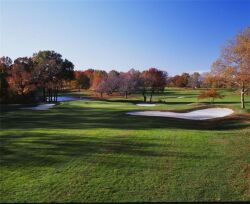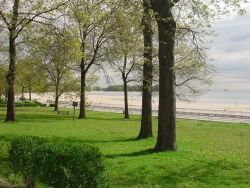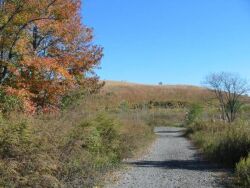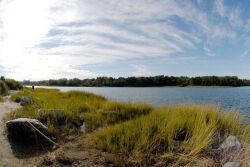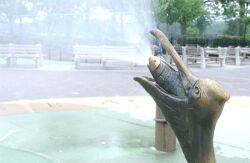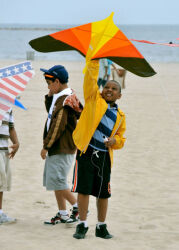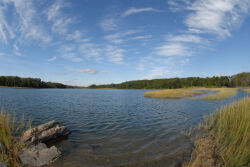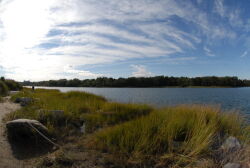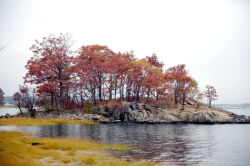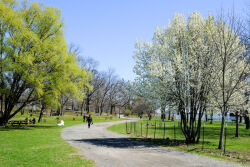Pelham Bay Park
Osprey in New York City Parks - Pelham Bay Park
More than three times the size of Manhattan's Central Park, Pelham Bay Park is the City's largest park property. Visitors to the park enjoy miles of bridle paths and hiking trails, Orchard Beach, the Bartow-Pell Mansion, two golf courses, and a breathtaking 13-mile saltwater shoreline that hugs Long Island Sound. Pelham Bay Park also has a wide and diverse range of plant and animal life, and features prime locations to view one of nature’s most skillful hunters, the osprey.
The osprey (Pandion haliaetus) will plummet from up to 150 feet in the air and execute dramatic feet-first diving attacks on live fish, sometimes completely submerging itself before flying off with its prey trapped in its fierce talons. With the aid of a reversible toe and spiky, barbed footpads, ospreys are able to maneuver fish mid-flight into a headfirst position in order to reduce drag. They are distinguishable by their brown backs, wings, and tails, white undersides, and distinctive brown stripe running across their heads. Like most predators, females are larger than males. A female’s wingspan can reach 5 feet, while a male’s approaches 4 feet. These birds also build large nests – at least 3 feet deep and 5 feet wide, although they can reach heights of up to 10 feet. Highly adaptable to their environment, ospreys are known to nest in both natural areas, such as trees, and man-made ones, such as light-posts and utility poles.
Ospreys are among the world’s most widespread animals, found on all continents but Antarctica. However, in the 1950s and 60s, the eastern United States lost a considerable portion of its osprey population due to the use of DDT (dichlorodiphenyltrichloroethane) in agricultural pesticides. Pesticides containing DDT washed off farmers’ fields and into streams and rivers, where the chemicals accumulated in fish. The ospreys then ate the contaminated fish, ingesting the chemicals, which caused the shells of osprey eggs to become too weak to support the weight of incubation. The eggs would shatter before the fledglings could hatch, and by the time DDT was finally banned in 1972, the eastern U.S. had seen a dramatic decrease in the number of nesting ospreys. In the 1940s, between New York City and Boston, there were 1000 active nests; by 1969, there were 150. DDT also harmed the nation’s peregrine falcons (Falco peregrinus) and bald eagles (Haliaeetus leucocephalus).
Eventually, the nation’s ecosystems were purged of dangerous DDT levels, and the osprey population began once more to thrive under the Endangered Species Act. In 1983, the osprey’s status was downgraded from its 1976 listing of “Endangered” to “Threatened,” and, in 1999 it was downgraded once again to “Special Concern.” Today, there are over 230 breeding pairs in lower New York State, mostly concentrated on the eastern coast of Long Island. Pelham’s Thomas Pell Wildlife Refuge, created in 1967, is now one of the best places in the City to view osprey, with the third highest number of osprey sightings in the country, according to the Audubon Society’s hawkwatches.
Check out your park's Vital Signs
Clean & Safe
Green & Resilient
Empowered & Engaged Users
Share your feedback or learn more about how this park is part of a
Vital Park System

Know Before You Go

Contacts
Pelham Bay Park Administrator's Office: (718) 430-1891
Bartow-Pell Mansion Museum: (718) 885-1461
Park Enforcement Patrol: (718) 430-1815
Pelham Bay & Split Rock Golf Course: (718) 885-1258
Turtle Cove Driving Range: (718) 885-2646
Orchard Beach Nature Center: (718) 885-3466
Urban Park Rangers: (718) 548-0912
Events and General Parks Information: 311
Bronx Equestrian Center: (718) 885-0551
Friends of Pelham Bay Park: (718) 430-4685
Bronx Recreation: General Information: (718) 430-1825
Bronx Recreation: Special Events Permits: (718) 430-1848
Bronx Recreation: Sports Permits: (718) 430-1840
Bronx Recreation: Tennis Permits: (718) 430-1848

